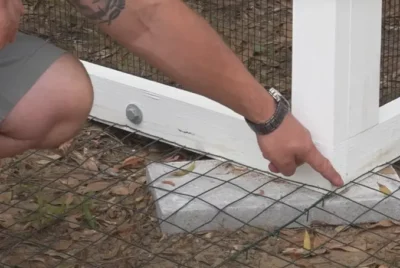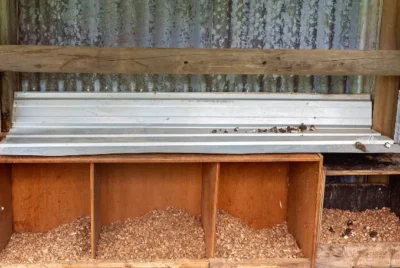The Importance of Heavy-Duty Latches in Protecting Your Chickens From Raccoons
As a chicken owner, one of your primary concerns is the safety and well-being of your flock. Chickens, being relatively defenseless, are vulnerable to various predators, with raccoons ranking high on the list. These nocturnal creatures are notorious for their intelligence and dexterity, making them adept at breaching standard security measures.
So, this article delves into why heavy-duty latches safeguard your chickens against raccoon attacks.
What Is Heavy-Duty Latches?
Heavy-duty latches are robust locking mechanisms that provide secure closure and protection for various applications. These serve the critical purpose of safeguarding the coop’s entry points, such as doors or gates.
Moreover, these latches are constructed with durable materials and are often designed to resist tampering or forced entry attempts by potential predators like raccoons, foxes, or coyotes.
By ensuring a strong and reliable closure, heavy-duty latches help maintain the safety of the chickens inside the coop, preventing predators from gaining access and potentially harming or stealing

Types of Heavy-Duty Latches Suitable for Chicken Coops
- Spring-Loaded Latches: These latches automatically close and lock when the door is shut, requiring significant force to open. Their spring mechanism makes it difficult for raccoons to manipulate.
- Twist Latches: A twist latch requires a specific twisting motion to open, which is a complex action for raccoons. These latches are simple for humans but challenging for animals.
- Sliding Bolt Latches: This type involves a bolt that slides into a catch. Upgrading to a heavy-duty version means a sturdier bolt and catch, making it harder for raccoons to slide it open.
- Lockable Latches: You can secure these with a padlock or combination lock. Even if a raccoon manages to tamper with the latch, the lock provides an additional layer of security.
- Lever Latches: Lever latches require lifting and then turning or pushing, a multi-step process that’s typically beyond the capability of most raccoons. Ensure they are sturdy and well-constructed.
- T-Handle Latches: Often used on sheds and barns, these latches can be quite secure, especially if they come with a locking mechanism. The T-handle design is difficult for raccoons to grip and turn.
- Magnetic Latches: These use a strong magnet to hold the door closed and require a substantial amount of force to open. However, you should use them with another type of latch for maximum security.
- Latch and Carabiner Combo: A simple latch can be made more secure by adding a carabiner or a similar locking device that raccoons can’t easily open.
Advantages of Heavy-Duty Latches Over Standard Latches
Enhanced Security
Heavy-duty latches offer superior security compared to standard latches. Their robust construction and often intricate locking mechanisms make it significantly more difficult for predators to manipulate or force open the coop’s doors or gates. This added security is crucial for protecting your chickens from potential harm or theft.
Resistance to Tampering
Heavy-duty latches are designed to resist tampering efforts by determined predators. Their durability and reinforced components make it challenging for creatures like raccoons or foxes to pry them open, ensuring that the coop remains securely locked even when faced with persistent threats.
Durability and Longevity
One of the key advantages of heavy-duty latches is their durability and longevity. These latches are typically constructed from high-quality materials such as stainless steel, heavy-duty aluminum, or hardened plastics, which are built to withstand the elements and daily wear and tear. As a result, they are less prone to rust, corrosion, or wear over time compared to standard latches.
Customization Options
Many heavy-duty latches offer customization options, allowing you to choose the level of security that suits your specific needs. Whether it’s a combination lock, a padlock compatibility feature, or additional reinforcement accessories, you can tailor these latches to your coop’s unique security requirements.

Key Features to Look for in Heavy-Duty Latches
When selecting heavy-duty latches for your chicken coop, it’s essential to consider several key features to ensure they effectively safeguard your coop. Here are the critical features to look for:
Materials and Construction
Ensure that the latch is made from high-quality and durable materials, such as stainless steel, heavy-duty aluminum, or reinforced plastics. Robust construction is vital to withstand the rigors of outdoor use, resist corrosion, and provide long-lasting security.
Locking Mechanisms
Evaluate the latch’s locking mechanisms carefully. Heavy-duty latches often feature complex and tamper-resistant locking systems, including bolts, hooks, or combination locks. Look for mechanisms that are secure and challenging for predators to manipulate.
Ease of Installation and Use
Choose a latch that is easy to install and operate. It should come with clear installation instructions and all the necessary hardware. A latch that is user-friendly ensures that you can securely lock and unlock the coop without hassle, especially during daily chores.
Compatibility with Different Coop Designs
Ensure that the latch is adaptable to various coop designs and materials. Some latches come with adjustable components or versatile mounting options, allowing them to fit different door or gate configurations. This flexibility is essential if you plan to change your coop in the future.
Weather Resistance
Heavy-duty latches should be designed to withstand exposure to various weather conditions, including rain, snow, and UV radiation. Look for features like rust-resistant coatings or seals that protect the latch from moisture and environmental factors.
Predator Resistance
Opt for latches specifically designed to resist tampering by common coop predators, such as raccoons, foxes, or coyotes. Tamper-resistant features might include concealed screws, reinforced strike plates, or mechanisms that are difficult to grasp or pry open.
Locking Options
Consider whether you want the option to use padlocks or combination locks with your latch for added security. Some heavy-duty latches are designed to accommodate such locks, providing an extra layer of protection.

Steps for Installing Heavy-Duty Latches on Chicken Coops
Installing heavy-duty latches on your chicken coop is an essential step to ensure the safety and security of your birds. Here are the steps to follow when installing heavy-duty latches on a chicken coop:
Tools and Materials Needed:
- Heavy-duty latch and accompanying hardware (screws, bolts, nuts, washers)
- Screwdriver or power drill with appropriate bits
- Measuring tape
- Pencil or marker
- Level
- Safety glasses
Step 1: Choose the Location
Start by selecting the location for your heavy-duty latch. This should be on the door or gate that provides access to your chicken coop. Ensure that it’s at a comfortable height for you to reach and operate easily.
Step 2: Mark the Position
Use a measuring tape to mark the exact position where you want to install the latch. Make sure it’s aligned with the coop’s frame and will securely hold the door or gate closed. You can use a pencil or marker to mark the positions of screw holes.
Step 3: Attach the Latch
Depending on the specific design of your heavy-duty latch, you may need to attach multiple components. Follow the manufacturer’s instructions to assemble the latch properly. Once assembled, hold it against the marked position on the coop’s frame.
Step 4: Pre-Drill Screw Holes
Using a power drill with an appropriate bit, pre-drill holes for the screws or bolts that will secure the latch in place. Pre-drilling helps prevent the wood from splitting or cracking when you insert the screws.
Step 5: Attach the Latch Securely
With the latch in place and the pre-drilled holes ready, insert the screws or bolts through the latch’s screw holes and into the coop’s frame. Use a level to ensure that the latch is properly aligned and straight. Then, tighten the screws or bolts securely, making sure the latch is firmly attached.
Step 6: Test the Latch
Test the latch to ensure it operates smoothly and securely holds the door or gate closed. Make any necessary adjustments to ensure a snug fit and proper locking.
Step 7: Locking Mechanism (if applicable)
If your heavy-duty latch has a locking mechanism that accommodates padlocks or combination locks, install the lock according to the manufacturer’s instructions. This adds an extra layer of security to your coop.
Step 8: Final Inspection
Once you are confident that the latch is securely installed and functions correctly, do a final inspection to ensure there are no loose components or sharp edges that could pose a safety hazard to you or your chickens.
Read also: How To Fox-Proof and Raccoon-Resistant Your Chicken Coop
Routine Maintenance to Ensure Latch Effectiveness
Routine maintenance is crucial to ensure the continued effectiveness of heavy-duty latches on your chicken coop. Regular checks and upkeep will help keep the latch in good working condition, enhancing the security of your coop. Here are some routine maintenance steps to follow:
Visual Inspection
Conduct a visual inspection of the latch regularly. Look for signs of wear, rust, or damage to the latch, locking mechanisms, and any associated hardware. Pay attention to any loose screws, bolts, or nuts.
Lubrication
Lubricate moving parts of the latch, such as hinges or pivots, with a suitable lubricant (e.g., silicone spray or graphite powder). Lubrication prevents friction and ensures smooth operation. Moreover, be cautious not to over-lubricate, as excess lubricant can attract dirt and debris.
Cleaning
Keep the latch and its surrounding area clean. Remove dirt, dust, and debris that might interfere with the latch’s functionality. Use a brush or a damp cloth to clean the latch and the gate or door it secures.
Tighten Hardware
Periodically check and tighten any screws, bolts, or nuts that hold the latch in place. Over time, vibrations and weather conditions can cause hardware to become loose, compromising the latch’s security.
Inspect Locking Mechanisms
If your latch has a locking mechanism, test it regularly to ensure it functions correctly. Lubricate the lock if needed, and replace any worn or damaged lock components promptly.
Check Alignment
Verify that the latch is still aligned properly with the door or gate it secures. Misalignment can affect the latch’s ability to lock securely. Adjust the latch as needed to ensure a snug fit.
Weatherproofing
If your coop is exposed to the elements, periodically inspect weather seals or gaskets on the latch. Replace any seals that have deteriorated or are no longer providing a tight seal against rain, snow, or dust.
Security Accessories
If you use additional security accessories, such as padlocks or combination locks, inspect them regularly for proper operation. Replace them if they show signs of wear or damage.
Reinforcement
Consider reinforcing the latch or the area around it if you notice repeated tampering attempts by predators. Adding additional hardware or security measures can further enhance the latch’s effectiveness.
Seasonal Adjustments
Make seasonal adjustments as necessary. Weather conditions can affect the fit and operation of latches. For example, in cold weather, hinges and locking mechanisms may become stiff, so extra lubrication and maintenance may be required.
Protect Your Chickens
The importance of heavy-duty latches in protecting your chickens from raccoons is crucial. Raccoons, with their clever and dexterous nature, are capable of opening simple latches, making it essential for you to invest in robust and secure latching mechanisms for your chicken coop.
By prioritizing the installation of heavy-duty latches, you can significantly reduce the risk of raccoon attacks, safeguard your poultry investment, and enhance the well-being and productivity of your flock. This simple yet effective measure is a cornerstone in responsible chicken husbandry and reflects your commitment to the welfare and protection of your chickens.
To further enhance your knowledge and fortify your coop against various threats, consider exploring “A Complete Guide to Advanced Chicken Coop Security Strategies.” This comprehensive resource provides in-depth information and practical tips to ensure the utmost safety for your feathered friends.




